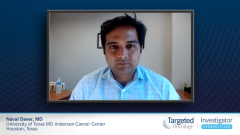
Emerging First-Line Treatments for High-Risk Myelodysplastic Syndrome
Dr. Naval Daver provides insight on the emerging first-line treatment options for high-risk myelodysplastic syndrome and breaks down clinical trial data.
Episodes in this series
Naval Daver, MD: There are many new emerging treatments both for low-risk
Among these, one that we’re very excited about is an agent called magrolimab, which targets CD47. The biology and mechanism of action of this therapy is unique to anything we have used in leukemia, in fact, for that matter, to anything we have used in solid tumors. We have been very familiar for many years with the concept of immune checkpoint blockade for T cells; blocking PD-1 on the surface of the T cells and PD-L1, its ligand, on the surface of a cancer cell, we remove the brakes on T cells, and the T cells come out from their exhaustion and become active and attack cancer cells. This has been very successful in many solid tumors and resulted in major breakthroughs in the treatment of those cancers.
However, we were not able to get the same degree of success with immune checkpoint-based therapies in AML and MDS despite efforts to try many different immune checkpoint approaches. What was started to be identified is that it may not be the T cells, but the macrophages that are major mediators of anti-tumor activity in both MDS and AML. This led to the development of an antibody that blocks the CD47 SIRP-alpha axis, CD47 present on the surface of cancer cells, and SIRP-alpha on the surface of macrophages. This also suppresses the macrophages by giving inhibitory signals. By blocking this axis using an antibody, we are now seeing that the macrophages are reactivated, rejuvenated, and very effective at seeking and attacking and killing MDS as well as acute myeloid leukemia cells.
This unique mechanism of action and the fact that CD47 is expressed at very high levels in almost all molecular and cytogenetic subsets of MDS led to initial phase 1b studies combining azacitidine with magrolimab. These have been presented by [David] Sallman, [MD,] and myself at multiple meetings over the last couple of years, where initially in MDS and then in acute myeloid leukemia in the frontline setting, the combination of magrolimab with azacitidine has shown very striking responses. Especially in MDS, we see the overall response rate is close to 85%, 90%, including a true complete remission with full recovery of count rate of about 45%-50%. To put this in perspective, the expected true complete remission [CR] rate with azacitidine alone is about 20%, so 45% to 50% is more than double.
The very nice aspect with this therapy has been that it has been overall safe and well tolerated. The only issue that we can see, and this is very time dependent during the first 1 to 7 days of treatment, is an on-target anemia. Anemia occurs because CD47 is expressed heavily on the surface of the red blood cells, especially the older red cells. When we initially give the CD47, the older red cells are coated with it, and they’re removed by the reticuloendothelial and the splenic system. We see initially, after the first or second dose, there can be a drop in hemoglobin. The usual amount of drop is between 0.5 to 1.3, 1.4 [g/dL]; not severe, but of course one must monitor and transfuse. Remember, these are older patients with MDS, and they may already be starting at 8.59 [g/dL]. It could drop to 7.0, 7.5 [g/dL], and those patients may need transfusions.
Other than this anemia, which we recommend very strongly to monitor for, I usually would suggest doing blood work daily or every other day during that first 6- to 7-day period, after which it appears that the CD47 is pruned off the surface of red cells and we no longer see that anemia. Other than this anemia, it’s an overall well-tolerated therapy. We do not see mucositis and nausea, vomiting, diarrhea, and we do not see many GI [gastrointestinal] adverse effects or musculoskeletal issues. In fact, we do not see much neutropenia or thrombocytopenia, which is I think one of the positive aspects of this agent compared to some of the others. We do see some infusion reactions in about 10% to 15% of patients, usually grade 1, and they can be mitigated with the use of steroids, and Benadryl [diphenhydramine], if needed.
At this point, the drug is being evaluated in a phase 3 randomized study called the ENHANCE study. This is of azacitidine alone, which is the standard of care in the United States, approved by the FDA and NCCN [National Comprehensive Cancer Network], versus the combination of azacitidine with magrolimab. The primary end point of this study is improvement in both the true CR rate and overall survival rate, and we hope to have the top-line results from this study in the next 1 to 1.5 years. If positive, of course it will result in the approval of this combination for the frontline treatment of MDS in the US and ex-US sites.
Transcript edited for clarity.









































